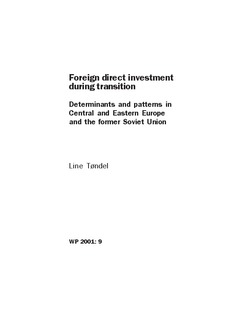| dc.contributor.author | Tøndel, Line | |
| dc.date.accessioned | 2008-02-26T11:16:52Z | |
| dc.date.accessioned | 2017-03-29T09:12:59Z | |
| dc.date.available | 2008-02-26T11:16:52Z | |
| dc.date.available | 2017-03-29T09:12:59Z | |
| dc.date.issued | 2001 | |
| dc.identifier.isbn | 82-90584-93-8 | |
| dc.identifier.issn | 0804-3639 | |
| dc.identifier.uri | http://hdl.handle.net/11250/2435991 | |
| dc.description.abstract | This paper provides an analysis of foreign direct investments to the countries of the former Soviet Union and 10 of the former socialist economies in Central and Eastern Europe (CEE). Foreign direct investments to the region is highly concentrated, Poland receiving close to 25 percent of the inflow on average from 1994-1998. There also appears to be a rather striking relationship of close psychic distance between host and source countries. Germany in particular, but also other Western European countries are the most important source countries for FDI in CEE. The Scandinavian countries are important in relative terms in the Baltic (B) countries. So is Asia in the Central Asian and Turkey in the Turkish speaking countries of the Commonwealth of Independent States (CIS). A regression analysis of data from 1994-1998 is performed to identify determinants of FDI. The results indicate a difference in motive for investing in CIS and in CEE and B. Whereas size of the market is a significant determinant in CIS, only progress in transition seems to influence the inflow of FDI in CEE and B. Natural resources were not included in the empirical analysis due to lack of data. However, the experience of countries such as Azerbaijan and Kazakhstan clearly indicate an important role for resource seeking activities in the area. The findings thus support a hypothesis of market seeking and resource-seeking investments prevail in CIS. Investments in CEE and B on the other hand appear more risk sensitive suggesting a role for the efficiency-seeking or vertical investments. Thus, as an economy progresses in transition and knowledge on the country is accumulated and available, market insecurity is reduced changing the nature of investment and increasing the level of investment. | |
| dc.language.iso | eng | |
| dc.publisher | Chr. Michelsen Institute | |
| dc.relation.ispartofseries | CMI Working paper | |
| dc.relation.ispartofseries | WP 2001: 9 | |
| dc.subject | Former Soviet Republics | |
| dc.subject | Central and Eastern Europe | |
| dc.subject | Baltic states | |
| dc.subject | Economies in transition | |
| dc.subject | Direct investments | |
| dc.subject | Foreign investments | |
| dc.subject | Statistical analysis | |
| dc.subject | Theory | |
| dc.title | Foreign direct investment during transition. Determinants and patterns in Central and Eastern Europe and the former Soviet Union | |
| dc.type | Working paper | |
